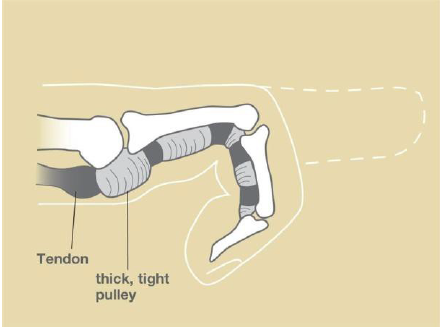Trigger Finger
What is trigger finger?
Trigger fingers are a result of tendons swelling underneath a pulley in the hand. They are very common. The pulleys help the tendons achieve a mechanical advantage with flexion of the fingers. Without pulleys, the tendons would “bowstring” and be weak.
Mechanism of a Trigger finger
The first pulley to the flexor tendon becomes stiff and less compliant. The tendon doesn’t fit and may become irritated and swollen. A swollen area on the tendon can become stuck as it travels underneath the pulley. This starts the cycle of catching and swelling. This catching or “triggering” of the tendon is where the name comes from
Who gets trigger fingers?
Trigger fingers are common in men and women after 35. Patients with one trigger finger are at risk for developing another trigger finger and also at risk for developing carpal tunnel syndrome. Trigger fingers can also be associated with diabetes and rheumatoid arthritis.
What are the symptoms of a trigger finger?
Pain and catching with a range of motion of the fingers are most common. A painful lump in the palm can occur as well. Frank catching of the finger does not have to happen—pain with extension or gripping may be the only symptoms. Symptoms are more common in the morning.
What is the treatment for trigger finger?
Splints, NSAIDs, and exercises have been proven not to be effective in treating trigger fingers. A single steroid injection may be curative in 50-75% of cases. This is less effective in those that have more than one finger affected or a recurrence after an injection. Surgical treatment is definitive and is required if someone has failed an injection, has rheumatoid arthritis or has insulin-dependent diabetes. Surgery is done under local anesthesia to ensure complete release.


